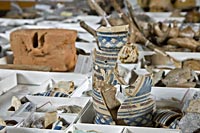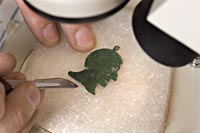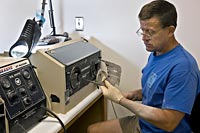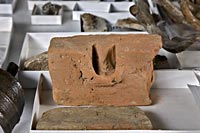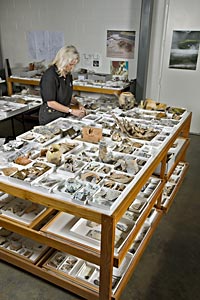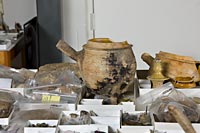Page content
Online Extras
Extra Images

Michael Lavin/Jamie May
A photo of the pendant, perhaps representing Powhatan, manipulated to show what it looked like new.

Michael Lavin
Inside the fort at Jamestown, in the cellar seen just below the back wall of a stone foundation, archaeologists found a pendant that dates to the Virginia colony’s earliest years. A seventeenth-century church tower and the 1907 tercentenary obelisk are also seen.

Curator and author Bly Straube stands holding the pendant in front of a table full of objects found in the same location.
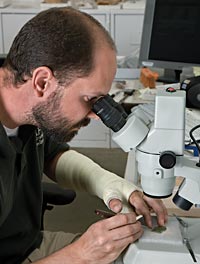
Jamestown conservator Michael Lavin works with a microscope to clean the age-thinned metal of the pendant.
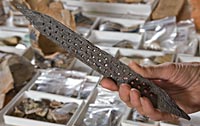
A jeweler’s draw plate, used to produce wire for decoration, was among the thousands of objects found in the cellar along with the pendant. Recovered items represented three distinct phases of use in that part of the fort, the colony’s original home on the James River.
In Praise or Damning Caricature?
An Early Seventeenth-Century Identification Badge
by Bly StraubeHistory and mystery are parts of my job. Curator for the Jamestown Rediscovery Project of APVA Preservation Virginia, I have the task of interpreting the more than a million artifacts excavated since 1994 from Jamestown Island, and to deduce their stories.
Never has there been so rich a collection of material culture contextually related to the site of England’s first permanent New World settlement: objects used, broken, discarded, and lost by the men, women, and children of Jamestown and their first fast-hold, James Fort. Thousands more made and used by Virginia Indians demonstrate how the cultures interwove.
All lead to a quest for meaning, which often informs an aspect of life at Jamestown not necessarily articulated in written records. Such is the case of a small copper object discovered on the original dirt floor of a circa 1607−17 cellar in James Fort.
It was the spring of 2008 and archaeologists had been working for weeks on the cellar, designated Structure 183. Aligned with the eastern palisade of the fort and ten feet from it, Structure 183 was a complicated feature with at least three phases of use. The colonists fashioned earthen steps into what first had been an industrial workshop. There was evidence of smithery, assaying, and lead-shot production. The ashy working surface was capped with clay to adapt the space for a bakery, evidenced by two circular bread ovens carved into the eastern wall. Beneath the cap, investigators found an unusual copper pendant, almost 400 years after it last saw the light of day.
One and a half inches long, the pendant profiles a man’s head and neck. The front and back of the thinly hammered object are engraved to show an individual with a prominent nose, a strong jawline, high cheekbones, and strongly defined brows and eyes. The hair is closely cropped and cut up over the ears—not an Englishman’s hairstyle of the day, which was typically long and flowing. Moreover, most Englishmen had facial hair.
For me, the first step in identifying such an object is a search for parallels in other archaeological assemblages, museum collections, or works of art. For puzzling small finds—the little portable objects that often provide the most important information—my first resource is Geoff Egan, finds specialist with the Museum of London. Egan is expert in sixteenth- and seventeenth-century material culture, and James Fort was chiefly supplied from London, so the archaeological assemblages from both areas are similar.
Egan endorsed my impression that this was a one-off piece, probably manufactured on site. “I guess,” he said, “the only ones who know whether it was done in praise or damning caricature” were “the creator and his circle.”
We may never know who made the pendant or why. In archaeological research, the outcome is usually peppered with such words as “maybe,” “perhaps,” and “possibly.” Our assessments must be made using what I think of as informed intuition. It is a best-guess interpretation based upon understanding the material culture and the contexts in which it is made and used.
We may never know who made the pendant or why. In archaeological research, the outcome is usually peppered with such words as “maybe,” “perhaps,” and “possibly.” Our assessments must be made using what I think of as informed intuition. It is a best-guess interpretation based upon understanding the material culture and the contexts in which it is made and used.
Powhatan, an important historical figure, is portrayed in a cartoonish illustration on Captain John Smith’s 1612 Map of Virginia, a de Bry workshop engraving of colonist Ralph Hamor’s meeting with Powhatan published in 1619, and in Smith’s “rescue” by Pocahontas that illustrated Smith’s 1624 Generall Historie. European artists produced these images years after the fact, and they cannot be considered accurate. The 1624 artist used figures derived from Roanoke colonist John White’s late sixteenth-century images of coastal Carolina Indians, “because the people differ very little from them of Powhatan.”
We know from the archaeological context that the pendant was fabricated in the early years of the seventeenth century, probably by a James Fort craftsman, and possibly one who had seen Powhatan. Archaeologists also found a jeweler’s draw plate. Perhaps that craftsman was jeweler Daniel Stallings, who arrived at Jamestown in 1608. He may have owned a draw plate, used to form decorative metal wire, that archaeologists found in Structure 183.
Powhatan never visited James Fort, but he had diplomatic meetings with the English at his capitals, Werowocomoco, twelve miles from Jamestown on the York River, and Matchcut, fifty miles from Jamestown on the Pamunkey River.
Smith, who met Powhatan in December 1607, wrote:
He is of personage a tall, well-proportioned man, with a sour look, his head somewhat gray, his beard so thin that it seems not at all, his age near 60; of a very able and hardy body to endure any labor.
William Strachey, in Virginia from 1610 to 1611, said:
He is a goodly old-man, not yet shrincking, though well beaten with many cold and stormy wynters. . . . Of a tall stature, and clene lymbes, of a sad aspect, rownd fat visag’d with gray haires, but playne and thyn hanging upon his broad showlders, some few haires upon his Chynne, and so on his upper lippe. He hath bene a strong and able salvadge, synowie, active, and of a daring spiritt, vigilant, ambitious, subtile to enlarge his dominions.
The pendant profile’s heavy emphasis around the eyes reflects a “sad aspect” and “sour look.” Powhatan’s wispy facial hair appears to be represented on the pendant by parallel lines drawn down from the chin.
So, the pendant may illustrate a Virginia Indian, and it may even depict Powhatan, but what was its purpose? Clues in the documentary record suggest that it may have been an identification badge used during diplomatic exchanges.
Such a clue survives from May 1614. Pocahontas, one of Powhatan’s daughters, had just married colonist John Rolfe, and, after more than four years of strife between the English and the Indians, there was peace. In 1609, Powhatan had besieged James Fort, confining the colonists and limiting their access to food. The Indians were “as fast killing without as the famine and pestilence within.” Retaliatory strikes against Indian towns killed inhabitants, burned houses, and destroyed cornfields.
But with the intercultural marriage, hostilities abated. Hamor reported that after the union, the English “had friendly commerce and trade, not onely with Powhatan himselfe, but also with his subjects round about us; so as now I see no reason why the Collonie should not thrive a pace.”
Governor Thomas Dale sent Hamor as his envoy to Powhatan to ask for a bride of his own. Hamor told Powhatan that Dale “hath taken resolution to dwell in your country so long as he liveth.”
The quarry was Pocahontas’s younger sister, a girl almost twelve years old, said to be the Indian chief’s “delight and darling.” Hamor was to offer three times the original bride-price, including beads, copper, hatchets, knives, wooden combs, fishhooks, and a grinding stone for the girl to become the governor’s “nearest companion, wife, and bedfellow.”
Hamor set out on his diplomatic mission accompanied by two Indian guides and an interpreter, Thomas Savage, an English boy “who had lived three years with Powhatan,” who spoke “the language naturally” and was “one whom Powhatan much affecteth.”
In the vicinity of Powhatan’s “court or residence” the emissaries camped in the open on the opposite side of the river from the Indian town so that they would be easily discovered. Then the guides called for a canoe to ferry the “two English sent upon businesse to Powhatan from the English” commander.
Powhatan welcomed them, greeting Savage as “my childe” and lamenting that he had not seen the youth in four years. He turned his attention to Hamor by running his hands around the Englishman’s neck. Hamor feared for a moment that Powhatan was thinking about cutting his throat, but he was searching for a pearl necklace that Powhatan and Dale had agreed would be the sign of an official English emissary.
Powhatan presented the necklace to Dale as a gift in 1610, and Dale told Powhatan any envoy of his would wear it. If an Englishman requested an audience without the necklace, Powhatan was to “binde him and send him home againe.” This was a way to ensure that the envoy was from the governor and was not a runaway colonist speaking for himself—of which there were many.
Hamor had not been told about this symbol of identification. Thinking fast, he said the arrangement only applied if an Englishman arrived without an Indian guide acquainted with his business. That seemed to satisfy Powhatan. Nevertheless, the girl had already been sold to a “great Weroance”—the Indians’ term for a leader—as his wife.
Because messengers or representatives usually transacted official business between leaders of the colony and the chiefdom, identity was an issue. How could the message be trusted without verification of the messenger? For Powhatan, the chain of pearls was the English emissary’s identification badge. For the English, why not a copper medallion in the likeness of Powhatan?
There are examples of copper pendants used by the English to sort out identity in the web of Indian relationships. The colonists had established their settlement in the middle of a chiefdom of more than thirty tribal groups governed by one man. But not all Indian groups in the area were part of Powhatan’s chiefdom, and those that were did not always adhere to his policies. It was difficult at times to distinguish enemies from friends, especially when they were similarly attired. This was a frustration expressed by the English colonizing Roanoke Island two decades before Jamestown. The English proposed to give friendly Indians a token or badge to wear “whereby we might know them to be our friends, when we met them anywhere out of the towne or Island.”
The James Fort colony took a similar approach with the Chickahominy Indians, who lived about seven miles from Jamestown. The Chickahominy were not part of the Powhatan chiefdom but were independently ruled by an eight-man council. Soon after the peace established with Powhatan in 1614, the Chickahominy gave up their tribal name to become tassantasses, or Englishmen, accepting King James as their king, and Governor Dale as his deputy. They agreed not to kill colonists or their cattle, to pay an annual tribute of two bushels of corn per fighting man, and to provide 300 or 400 bowmen when necessary to help the English fight the Spanish. The new Englishmen were instructed not to enter any English settlement without first announcing themselves. Otherwise, how would the English know they were tassantasses?
Each of the eight elders accepted symbols of their new status so that there would be no chance of mistaken identity. Yearly, each was to receive a red coat from King James, and each was to be given “the picture of his Majesty, ingraven in Copper, with a chaine of Copper to hang it about his necke, wherby they shall be knowne to be King IAMES his noble Men.”
Here is direct evidence of the use of copper medallions engraved with the image of a political leader. As historian Karen Kupperman has pointed out, by choosing copper pendants for the Chickahominy identification badges, the English were selecting markers like the copper gorgets of status customarily worn by weroances. The native population accepted the solution because it conformed with an established practice.
Identification badges for controlling friendly Indian access to English settlements continued through the seventeenth century. By a 1646 treaty with a new Powhatan chief, Necotowance, his Indian emissaries were required to wear badges or striped coats issued by the English authorities “in order to avoid all injury to such messenger.” The injury was invariably death.
In 1662, to limit native access to English lands, the English issued copper and silver badges to Indian “kings” under their protection. The badges were inscribed with names of Indian towns and were to be carried by Indians whenever they entered English territory. Several of these badges have survived and are in collections of The Colonial Williamsburg Foundation, the Virginia Historical Society, and the Jamestown-Yorktown Foundation, as well as in private hands.
In our age, identity is still an issue, and we use similar means to attempt to isolate individuals who intend us harm. Passports, drivers’ licenses, Social Security numbers, and video cameras track our movements and verify who we are, much as the copper badges Virginia Indians wore. More sophisticated methods have been initiated in Fallujah, Iraq, where terrorists move freely among civilians. Biometric ID badges based on fingerprints and iris scans are provided to all city residents so the authorities can monitor the movements and activities of individuals. The Iraqis are said to welcome the system, which provides a safe environment for them to go about their lives. The same might be said about the ID badges used in seventeenth-century Virginia. They worked to verify the identities of those with whom alliances could be established and maintained for a peaceful existence.
Extra Images
Bly Straube, is senior curator of the Jamestown Rediscovery Project, APVA Preservation in Virginia. This is her first contribution to the journal.
Suggestions for further reading:
- Karen Ordahl Kupperman, Indians & English: Facing Off in Early America (Ithaca: Cornell University Press, 2000).
- Podcast: Tangible Remains with Bly Straube (Dec. 14, 2009)
- Podcast: Jamestown Unearthed, Part One

